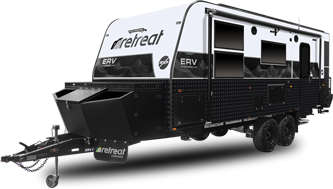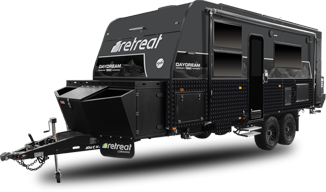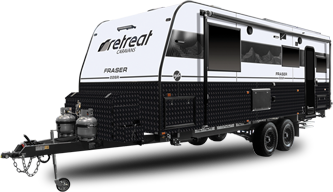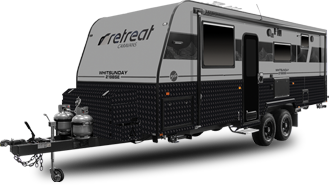
Seasonal Off-Road Caravanning: Best Times to Explore Victoria
Victoria’s landscape offers the full spread—from alpine climbs to coastal bushland, from dusty desert tracks to lush rainforest trails. But timing matters. One season’s dream trip can turn into another season’s bogged van or road closure. That’s why knowing the best times to explore Victoria’s off-road tracks is more than a bonus—it’s essential.
Some areas become too risky in winter. Others come alive after summer rain. If you’re planning to go off-grid, the right season shapes everything: road access, weather, gear needs and even how crowded your campsite will be. That’s especially true for travellers using off-grid caravans, who rely on nature and setup more than local amenities.
This guide breaks down what each season in Victoria really means for off-road adventurers—where to go, what to expect and how to make the most of your trip.
Autumn Adventures: Victoria’s Sweet Spot
Autumn might be the best season for off-road travel in Victoria. From March through May, the weather cools down without turning wild. Rain is light, tracks are still dry and the crowds ease off after the summer peak.
You can expect daytime temperatures between 15°C and 25°C, which means less heat stress on both you and your van. It also means fewer bugs, more wildlife and better sleep at night. The roads through bushland and ranges are stable, especially in places like the Otways and the Lerderderg State Park.
Families with kids often aim for camping during school holidays in Victoria, and autumn makes that easy without the peak summer hassle. The Easter break is one of the most popular times, so booking ahead is smart if you’re heading to known sites.
Try the Wombat State Forest for mid-elevation bush camping or check out the Pyrenees for quiet trails with a view. Both have tracks suited for off-road setups and plenty of remote spots if you’re set up for dry camping.
Winter in the Wild: When Cold Meets Capability
Winter caravanning isn’t for everyone, but for some, it’s the best time to be out. From June to August, the snow hits the alpine regions, the tracks get muddy and many roads close due to weather. But that doesn’t mean all adventures stop.
Instead of heading up into the High Country, try the west and north-west. The Big Desert Wilderness Park and Little Desert National Park offer wide-open spaces with crisp, dry air. You’ll see fewer people, clearer skies and a whole new side of Victoria that many miss.
You’ll need a strong 12V setup, as the sun sits lower and days are shorter. Solar recharge is slower, and heating becomes more important than cooling. Diesel heaters are worth their weight. Planning for extra blankets, rain-proof gear and recovery tools is also smart. Wet clay tracks are slippery even with good tyres.
The key is staying in low-rainfall zones. Avoid high-altitude spots and instead follow seasonal camping destinations in Victoria that offer reliable road access year-round. If you can handle the cold, winter gives you peaceful campsites, no dust and quiet nights under the stars.
Spring Tracks: Rebirth of the Bush
Spring is all about growth. Wildflowers bloom, rivers fill and animals come out in force. From September to November, Victoria shakes off the chill and opens up fresh tracks for those ready to explore.
It’s also a time when weather can swing quickly. One day it’s 28°C and sunny, the next you’re dealing with storms or late frost. So flexibility is key. Stick to areas with solid road maintenance, and always check park access before heading out.
In spring, places like Mount Buangor and the Mitchell River National Park shine. Bushland turns green, creeks flow and the views stretch for miles. These areas aren’t always suitable in winter, but spring makes them ideal for off-road setups.
This season is also great for testing out newer features or systems on your van. The conditions let you experience hot days and cool nights, giving a proper test for climate control, water tanks and solar setups. Many travellers who want top camping spots in Victoria for year-round adventures start their testing in spring for this reason.
Spring also marks the start of snake season, so keep a tidy camp and stay alert on walks. It’s part of the balance when travelling through wild country.
Summer: Heat, Dust and High Rewards
From December to February, summer brings out both the best and worst of off-road travel. The long days, dry tracks and warm nights are great for adventure. But you’ll also face heatwaves, total fire bans and packed campsites.
High Country routes like Davies Plain or Blue Rag Range open up in summer, offering 4WD tracks with incredible views and rugged climbs. These tracks often close in wetter months, so summer is your only window to access them. If you’ve got good clearance, cooling systems and recovery gear, summer can take you to places other seasons won’t.
But heat control is crucial. Caravans without proper ventilation or awnings will bake. Travellers often add shade sails or insulated window covers to combat inside temps pushing 40°C. It’s also the time when your battery and solar systems get worked hard by fridges running overtime.
Bushfire risk is serious. Always check local alerts before heading out and avoid fire-prone zones during code red days. Carry extra water and fuel, as services in rural zones may close due to fire restrictions or holiday hours.
If you’re after solitude, go early in December or late in February to avoid the peak rush. Some desert tracks are at their best in dry conditions—but only if your setup can handle the heat.
Weather by Region: Know What to Expect
Victoria’s regions don’t behave the same, even within the same season. The coast can be 10 degrees cooler than the inland plains. Snow can hit mountain passes while you’re wearing shorts an hour away.
Here’s a quick overview:
- High Country: Best in summer and early autumn. Avoid winter due to closures and snow.
- Mallee and Desert Parks: Best in winter or late autumn. Avoid summer due to heat and fire risk.
- Great Ocean Road and Otways: Spring and autumn are ideal. Summer is busy. Winter can be wet.
- Gippsland Forests: Spring and autumn offer clear roads and cooler temps. Winter gets slick.
This is why smart travellers watch both the season and the local climate zone. Your plan might be solid for the time of year—but fail due to local flooding or heat.
Planning Around School Holidays and Long Weekends
Timing your trip with public holidays or school breaks can go two ways. If you’ve got kids, syncing your trip makes sense. But if you want quiet, these dates bring more people, crowded tracks and busy campgrounds.
In peak periods like Easter, Christmas and long weekends, some free sites fill by 10am. So either book early or travel off-grid to less-known spots. Off-road caravans give you that freedom—if you’ve packed right.
It’s also worth knowing that many regional councils boost ranger patrols and enforcement during peak seasons. So if you’re free camping, make sure you’re parked in permitted zones and not risking a fine.
Track Conditions and Road Access by Season
Not all roads are equal. A track open in autumn might be impassable in spring after heavy rain. Some are closed for months to protect them from damage or to avoid risk to travellers.
Before every trip, check:
- Local council road updates
- Parks Victoria alerts
- Bureau of Meteorology (BOM) rainfall maps
Unsealed tracks in national parks often close first. In places like the Avon Wilderness or Baw Baw area, even moderate rain can make roads unfit for towing. When in doubt, call ahead to local ranger stations—they’ll know if it’s worth the risk.
A smart move is to build two plans: one for dry conditions and a backup route in case of closures. Flexibility keeps your trip on track even if the weather doesn’t play nice.
Gearing Up for Each Season
Your caravan gear should match the season. The basics—good tyres, water tanks, power system—never change. But the extras shift depending on temperature, weather and daylight hours.
In summer:
- Add shade gear, extra water tanks and cooling fans
- Use window shades and roof vents for airflow
- Avoid metal cookware that holds heat
In winter:
- Diesel heater or thermal blankets are worth packing
- Dry storage becomes more important with rain
- Carry recovery gear for soft or boggy roads
In spring and autumn:
- Monitor weather for storms or sudden cold snaps
- Take insect repellents and snake awareness kits
- Stay stocked for both heat and chill
Most seasoned travellers tailor their setup twice a year—once before the summer push, and again in late autumn before winter rolls in.
FAQs
1) When is the best overall time for off-road caravanning in Victoria?
Autumn is often seen as the best time for most travellers. Between March and May, the weather is stable, the crowds drop and tracks are usually dry. You’ll get cool nights and mild days, which makes sleeping easier and travel more comfortable. Tracks that close in winter are still open, and bushfire risk is low. It also avoids the pressure of school holidays in January. If you’re new to off-road caravanning or testing a new setup, autumn gives you the best mix of conditions.
2) Are there places to avoid during certain seasons?
Yes. In winter, the High Country and alpine routes often close or become too risky due to snow and rain. In summer, Mallee regions and desert parks can be dangerously hot, with high bushfire risk and limited shade. Coastal areas can get flooded in spring if storms roll through. Always check road conditions and fire danger ratings before heading out. Avoid unsealed tracks during wet seasons unless you’re fully prepared for recovery and self-sufficiency. Being flexible with your destination helps you stay safe.
3) What’s the best caravan setup for year-round travel in Victoria?
A balanced off-road setup is key. Look for independent suspension, all-terrain tyres, solar power, dual water tanks and a diesel heater. If you plan to travel in both summer and winter, insulation and climate control are vital. Use lithium batteries for reliable power across all seasons. Pack modular storage so you can switch gear in and out depending on the season. A roof vent, awning and external kitchen also make life easier in hot months. Aim for flexibility—gear that works in both extremes.
4) How do school holidays affect off-road travel?
School holidays bring more travellers, especially families. Campgrounds fill fast, and tracks near popular parks get busier. If you want quiet spots, travel midweek or outside peak periods. Remote sites are still accessible if you’re using an off-grid setup, but expect more traffic and noise at well-known places. Public holidays can also impact road access and local services, so plan fuel and supply stops ahead of time. Booking in advance is smart if you’re heading to a known destination during holiday periods.
5) What kind of weather warnings should I watch out for?
Watch for fire bans in summer, road closure warnings in winter and storm alerts in spring. The BOM website gives accurate local updates. Parks Victoria posts seasonal closures and track conditions. If you’re heading into desert areas, wind and dust alerts matter too. Storms can roll through fast, flooding unsealed roads in hours. Snow warnings affect alpine routes. Before every trip, check three things: weather radar, local fire conditions and park alerts. Being informed reduces the chance of turning back halfway through.
Ready to Roll: Timing Is Everything
Victoria gives off-road caravanners a full range of landscapes and experiences—but knowing when to go is half the battle. Every season changes how the land behaves, what gear you need and where you can go safely.
The best trips come when planning meets timing. Whether you’re aiming for the summer peaks or chasing crisp air in the desert, matching your setup with the season keeps the adventure smooth and stress-free.
For off-road builds that stand up to every season, Retreat Caravans offers setups designed for the tough stuff. Our off-grid caravans are built for remote travel—rain, shine or red dirt included. See below for our full range of caravans, all carefully designed with you in mind:







